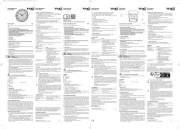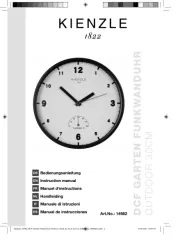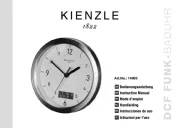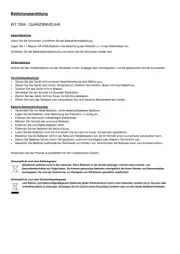
Vielen Dank, dass Sie sich für dieses Gerät aus dem Hause TFA entschieden
1. Bevor Sie mit dem Gerät arbeiten
•Lesen Sie sich bitte die Bedienungsanleitung genau durch.
•Durch die Beachtung der Bedienungsanleitung vermeiden Sie auch
Beschädigungen des Geräts und die Gefährdung Ihrer gesetzlichen Män-
gelrechte durch Fehlgebrauch.
•Für Schäden, die aus Nichtbeachtung dieser Bedienungsanleitung verur-
sacht werden, übernehmen wir keine Haftung.
•Beachten Sie besonders die Sicherheitshinweise!
•Bewahren Sie diese Anleitung gut auf!
3. Einsatzbereich und alle Vorteile Ihres neuen Gerätes auf einen Blick
• Funkuhr mit höchster Genauigkeit
• Analoge Zeitanzeige mit Sekundenzeiger
• Großes, gut ablesbares Zifferblatt
• Ideal für zuhause, das Büro, das Wartezimmer, den Eingangs- oder Emp-
fangsbereich und als Geschenk
• Das Produkt ist ausschließlich für den oben beschriebenen Einsatzbereich
geeignet. Verwenden Sie das Produkt nicht anders, als in dieser Anleitung
• Das eigenmächtige Reparieren, Umbauen oder Verändern des Gerätes ist
• Halten Sie das Gerät und die Batterie außerhalb der Reichweite von Kindern.
• Kleinteile können von Kindern (unter drei Jahren) verschluckt werden.
• Batterien enthalten gesundheitsschädliche Säuren und können bei Ver-
schlucken lebensgefährlich sein. Wurde eine Batterie verschluckt, kann dies
innerhalb von 2 Stunden zu schweren inneren Verätzungen und zum Tode
führen. Wenn Sie vermuten, eine Batterie könnte verschluckt oder ander-
weitig in den Körper gelangt sein, nehmen Sie sofort medizinische Hilfe in
• Batterien nicht ins Feuer werfen, kurzschließen, auseinandernehmen oder
aufladen. Explosionsgefahr!
• Um ein Auslaufen der Batterien zu vermeiden, sollten schwache Batterien
möglichst schnell ausgetauscht werden.
• Sollte eine Batterie ausgelaufen sein, vermeiden Sie Kontakt mit Haut,
Augen und Schleimhäuten. Spülen Sie ggf. umgehend die betroffenen Stel-
len mit Wasser und suchen Sie einen Arzt auf.
Wichtige Hinweise zur Produktsicherheit!
• Setzen Sie das Gerät keinen extremen Temperaturen, Vibrationen und
• Vor Feuchtigkeit schützen.
A: M SET Taste RESET TasteB:
• Ziehen Sie die Schutzfolie vom Display.
• Legen Sie eine neue Batterie 1,5 V AA polrichtig ein.
• Das Gerät ist jetzt betriebsbereit.
6.1 Empfang der Funkzeit DCF
• Die Zeiger stellen sich auf 12.00 Uhr.
• Die Uhr versucht nun das DCF-Funksignal zu empfangen.
• Wenn der Zeitcode nach ein paar Minuten empfangen wurde, wird die funk-
gesteuerte Zeit ständig im Display angezeigt.
• Ist der Empfang nicht erfolgreich, wird der Empfang zu jeder vollen Stunde
erneut aktiviert. Insgesamt gibt es 12 Versuche.
Hinweis zum Empfang der Funkzeit:
Die Zeitübertragung erfolgt von einer Cäsium Atom-Funkuhr, die von der Phy-
sikalisch Technischen Bundesanstalt in Braunschweig betrieben wird. Die
Abweichung beträgt weniger als 1 Sekunde in einer Million Jahren. Die Zeit ist
kodiert und wird von Mainflingen in der Nähe von Frankfurt am Main durch ein
DCF-77 (77.5 kHz) Frequenzsignal übertragen mit einer Reichweite von ca.
1.500 km. Ihre Funkuhr empfängt das Signal, wandelt es um und zeigt immer
die exakte Zeit an. Auch die Umstellung von Sommer- und Winterzeit erfolgt
automatisch. Der Empfang hängt hauptsächlich von der geographischen Lage
ab. Im Normalfall sollten innerhalb des Radius von 1.500 km ausgehend von
Frankfurt bei der Übertragung keine Probleme auftauchen.
Bitte beachten Sie folgende Hinweise:
• Es wird empfohlen, einen Abstand von mindestens 1,5 – 2 Metern zu even-
tuell störenden Geräten wie Computerbildschirmen und Fernsehgeräten
• In Stahlbetonbauten (Kellern, Aufbauten) ist das empfangene Signal natür-
licherweise schwächer. In Extremfällen wird empfohlen, das Gerät in Fen-
sternähe zu platzieren, um das Funksignal besser zu empfangen.
• Nachts sind die atmosphärischen Störungen meist geringer und ein Emp-
fang ist in den meisten Fällen möglich. Ein einziger Empfang pro Tag
genügt, um die Genauigkeit zu gewährleisten und Abweichungen unter
6.2 M SET Taste - Manuelle Einstellung der Uhrzeit
• Falls die Funkuhr kein DCF-Signal empfangen kann (z.B. wegen Störungen,
Übertragungsdistanz, etc.), kann die Zeit manuell eingestellt werden. Die
Uhr arbeitet dann wie eine normale Quarz-Uhr.
• Halten Sie die MSET Taste für drei Sekunden gedrückt
• Der Sekundenzeiger bleibt stehen.
• Halten Sie nun die MSET Taste gedrückt, bis die aktuelle Uhrzeit angezeigt
• Drücken Sie die MSET Taste nur kurz, rückt der Zeiger eine Minute vor.
• Nach ein paar Sekunden bewegt sich der Sekundenzeiger weiter.
• Bei erfolgreichem Empfang des DCF-Funksignals wird die manuell einge-
stellte Zeit überschrieben.
• Sie können die Initialisierung auch manuell starten.
• Drücken Sie für drei Sekunden die REC Taste.
• Die Zeiger stellen sich auf 12.00 Uhr.
• Die Funkuhr versucht nun das DCF-Funksignal erneut zu empfangen.
• Drücken Sie die RESET Taste mit einem spitzen Gegenstand, wenn das
Gerät nicht einwandfrei funktioniert.
• Reinigen Sie das Gerät mit einem weichen, leicht feuchten Tuch. Keine
Scheuer- oder Lösungsmittel verwenden!
• Entfernen Sie die Batterie, wenn Sie das Gerät längere Zeit nicht verwenden.
• Bewahren Sie Ihr Gerät an einem trockenen Platz auf.
• Wenn die Funktionen des Gerätes schwächer werden, wechseln Sie bitte die
• Legen Sie eine neue Batterie 1,5 V AA polrichtig ein.
Keine Zeigerbewegung Batterie polrichtig einlegen➜
Kein DCF Empfang REC Taste für drei Sekunden drücken ➜
und Initialisierung starten
➜ Empfangsversuch in der Nacht abwarten
➜ Anderen Aufstellort für das Gerät
➜ Uhrzeit manuell einstellen
➜ Beseitigen der Störquellen
➜ Neuinbetriebnahme des Gerätes gemäß
Unkorrekte Anzeige RESET Taste mit einem spitzen Gegen-➜
Wenn Ihr Gerät trotz dieser Maßnahmen immer noch nicht funktioniert, wen-
den Sie sich an den Händler, bei dem Sie das Produkt gekauft haben.
Dieses Produkt und die Verpackung wurden unter Verwendung hochwertiger
Materialien und Bestandteile hergestellt, die recycelt und wiederverwendet
werden können. Dies verringert den Abfall und schont die Umwelt.
Entsorgen Sie die Verpackung umweltgerecht über die eingerichteten Sam-
Entsorgung des Elektrogeräts
Entnehmen Sie nicht festverbaute Batterien und Akkus aus dem Gerät
und entsorgen Sie diese getrennt.
Dieses Gerät ist entsprechend der EU-Richtlinie über die Entsorgung
von Elektro- und Elektronik-Altgeräten (WEEE) gekennzeichnet.
Dieses Produkt darf nicht mit dem Hausmüll entsorgt werden. Der
Nutzer ist verpflichtet, das Altgerät zur umweltgerechten Entsorgung
bei einer ausgewiesenen Annahmestelle für die Entsorgung von Elek-
tro- und Elektronikgeräten abzugeben. Die Rückgabe ist unentgeltlich.
Beachten Sie die aktuell geltenden Vorschriften!
Batterien und Akkus dürfen keinesfalls in den Hausmüll. Sie enthalten
Schadstoffe, die bei unsachgemäßer Entsorgung der Umwelt und der
Gesundheit Schaden zufügen können. Als Verbraucher sind Sie
gesetzlich verpflichtet, gebrauchte Batterien und Akkus zur umweltge-
rechten Entsorgung beim Handel oder entsprechenden Sammelstellen
gemäß nationalen oder lokalen Bestimmungen abzugeben. Die Rück-
Die Bezeichnungen für enthaltene Schadstoffe sind:
Cd=Cadmium, Hg=Quecksilber, Pb=Blei.
Spannungsversorgung: Batterie 1 x 1,5 V AA (nicht inklusive)
Gehäusemaße: 300 x 43 x 300 mm
Gewicht: 664 g (nur das Gerät)
Diese Anleitung oder Auszüge daraus dürfen nur mit Zustimmung von TFA Dost-
mann veröffentlicht werden. Die technischen Daten entsprechen dem Stand bei
Drucklegung und können ohne vorherige Benachrichtigung geändert werden.
Die neuesten technischen Daten und Informationen zu Ihrem Produkt finden Sie auf
unserer Homepage unter Eingabe der Artikel-Nummer in das Suchfeld.
Hiermit erklärt TFA Dostmann, dass der Funkanlagentyp 60.3522 der Richtlinie
2014/53/EU entspricht. Der vollständige Text der EU-Konformitätserklärung ist
unter der folgenden Internetadresse verfügbar:
www.tfa-dostmann.de/service/downloads/ce
E-Mail: info@tfa-dostmann.de
TFA Dostmann GmbH & Co.KG
Zum Ottersberg 12, 97877 Wertheim, Deutschland 04/23
Horloge murale radio-pilotée
Nous vous remercions d'avoir choisi l'appareil de la Société TFA.
1. Avant d'utiliser votre appareil
•Veuillez lire attentivement le mode d'emploi.
•En respectant ce mode d'emploi, vous éviterez d'endommager votre
appareil et de perdre vos droits légaux en cas de défaut si celui-ci résul-
te d’une utilisation non-conforme.
•Nous n'assumons aucune responsabilité pour des dommages qui
auraient été causés par le non-respect du présent mode d'emploi.
•Suivez bien toutes les consignes de sécurité !
•Conservez soigneusement le mode d'emploi !
2. Contenu de la livraison
• Horloge murale radio-pilotée
3. Aperçu du domaine d'utilisation et de tous les avantages de votre
• Horloge radio-pilotée de haute précision
• Affichage de l'heure analogique avec aiguille des secondes
• Grand cadran bien lisible
• Idéal pour la maison, le bureau, le hall d’entrée, la salle d’attente, la récep-
tion ou bien encore comme cadeau
• Le produit est destiné uniquement à l'utilisation décrite ci-dessus. N'utili-
sez jamais l’appareil à d'autres fins que celles décrites dans le présent
• Vous ne devez en aucun cas réparer, démonter ou modifier l'appareil par
• Placez votre appareil et la pile hors de la portée des enfants.
• Les petites pièces peuvent être avalées par les enfants (de moins de trois
• Les piles contiennent des acides nocifs pour la santé et peuvent être mortel-
les dans le cas d’une ingestion. Si une pile a été avalée, elle peut entraîner
des brûlures internes graves ainsi que la mort dans l’espace de 2 heures. Si
vous craignez qu’une pile ait pu être avalée ou ingérée d’une autre manière,
quelle qu’elle soit, contactez immédiatement un médecin d’urgence.
• Ne jetez jamais de piles dans le feu, ne les court-circuitez pas, ne les
démontez pas et ne les rechargez pas. Risque d'explosion !
• Une pile faible doit être remplacée le plus rapidement possible afin d'éviter
• Évitez tout contact de la peau, des yeux et des muqueuses avec le liquide
des piles. En cas de contact, rincez immédiatement les zones concernées à
l’eau et consultez un médecin.
Conseils importants de sécurité du produit !
• Évitez d’exposer l’appareil à des températures extrêmes, à des vibrations
• Protégez-le contre l'humidité.
A :Touche M SET Touche RESETB :
• Enlevez le film de protection du couvercle en verre.
• Insérez une nouvelle pile de type 1,5 V AA, en respectant la polarité +/- .
• Votre appareil est maintenant prêt à fonctionner.
6.1 Réception du signal DCF
• Les aiguilles se déplacent à 12.00 heures.
• L’horloge cherche le signal radio DCF.
• En cas de réception correcte après quelques minutes, l’heure radio est affi-
chée en continu sur l'écran.
• Si aucune réception n'est possible, la réception sera actualisée à chaque
heure. Le nombre total de tentatives possibles est 12.
Remarque pour la réception de l’heure radio DCF :
La transmission de l’heure radio-pilotée s’effectue via une horloge atomique
au césium, exploitée par la Physikalisch Technische Bundesanstalt de Braun-
schweig (Institut Fédéral Physico-Technique de Braunschweig). L’écart de pré-
cision de cette horloge est d' 1 seconde pour un million d’années. L’heure est
diffusée à partir de Mainflingen, près de Francfort-sur-le-Main, avec un signal
DCF-77 (77,5 kHz) d'une portée d’environ 1500 km. L'horloge radio-pilotée
reçoit le signal, le convertit et affiche l'heure précise. Le passage de l'heure
d'hiver à l'heure d'été et vice-versa s'effectue également en mode automati-
que. La réception dépend de votre position géographique. En règle générale,
dans un rayon de 1500 km autour de Francfort, aucun problème de transmis-
sion ne devrait apparaître.
Nous vous prions de respecter les consignes suivantes :
• Nous vous recommandons de respecter une distance de 1,5 - 2 m entre
l'appareil et d’éventuelles sources de signaux parasites, comme les écrans
d'ordinateurs et les postes de télévision.
• Dans les bâtiments en béton armé (caves, greniers aménagés), le signal reçu
est affaibli. Dans les cas extrêmes, nous vous conseillons de placer l’appareil
près d’une fenêtre de manière à améliorer la réception du signal radio.
• La nuit, les perturbations s’affaiblissent en règle générale et la réception est
possible dans la plupart des cas. Une seule réception par jour suffit pour
garantir la précision de l’affichage de l’heure et pour maintenir d’éventuels
écarts en dessous d' 1 seconde.
6.3 Touche M SET - Réglage manuel de l'heure
• Si votre horloge radio-pilotée ne peut pas recevoir le signal DCF (par exem-
ple en cas de perturbations, d'une distance de transmission excessive etc.),
vous pouvez régler l'horaire manuellement. L'horloge fonctionne alors
comme une horloge à quartz normale.
• Maintenez la touche MSET appuyée pendant trois secondes.
• L'aiguille des secondes s'arrête.
• Maintenez la touche MSET appuyée jusqu'à ce que l'heure correcte soit
• Appuyez sur la touche MSET brièvement et l’aiguille avancera d’une minute.
• Après quelques secondes, l’aiguille des secondes se déplace de nouveau.
• Lorsque la réception du signal DCF a abouti, l'heure ajustée manuellement
sera remplacée par l’heure radio.
• Vous pouvez également activer manuellement la réception.
• Appuyez sur la touche REC pendant trois secondes.
• Les aiguilles se déplacent à 12.00 heures.
• L’horloge cherche de nouveau le signal radio DCF.
• Appuyez sur la touche RESET avec un objet pointu si l’appareil ne fonction-
7. Entretien et maintenance
• Pour le nettoyage de votre appareil, utilisez un chiffon doux et humide.
N’utilisez pas de solvants ou d´agents abrasifs !
• Enlevez la pile si vous n'utilisez pas votre appareil pendant une durée pro-
• Conservez votre appareil dans un endroit sec.
7.1 Remplacement de la pile
• Remplacez la pile si les fonctions de l'appareil s'affaiblissent.
• Insérez une nouvelle pile de type 1,5 V AA en respectant la polarité +/-.
Aucun mouvement Contrôlez la bonne polarité de la pile➜
des aiguilles Changez la pile ➜
Pas de réception DCF Maintenez la touche REC appuyée pendant➜
trois secondes et activez manuellement la
réception de l'heure radio
➜ Attendez la réception du signal de nuit
➜ Sélectionnez une autre position pour votre
➜ Réglage de l'heure manuellement
➜ Éliminez les sources de parasitage
➜ Remettez la appareil en service,
conformément aux instructions
Affichage incorrect Appuyez sur la touche RESET à l'aide ➜
Si votre appareil ne fonctionne toujours pas malgré ces mesures, adressez-
vous au vendeur chez qui vous avez acheté votre appareil.
9. Traitement des déchets
Ce produit et son emballage ont été fabriqués avec des matériaux de haute
qualité qui peuvent être recyclés et réutilisés. Cela permet de réduire les
déchets et de protéger l’environnement. Éliminez les emballages de manière
respectueuse de l'environnement par le biais des systèmes de collecte établis.
Mise au rebut de l'appareil électrique
Retirez de l'appareil les piles et les batteries rechargeables qui ne
sont pas installées de façon permanente et jetez-les séparément.
Cet appareil est conforme aux normes de l'UE relatives au traitement
des déchets électriques et électroniques (WEEE).
L'appareil usagé ne doit pas être jeté dans les ordures ménagères.
L’utilisateur s’engage, pour le respect de l’environnement, à déposer
l’appareil usagé dans un centre de traitement agréé pour les déchets
électriques et électroniques. La collecte est gratuite. Respectez les
réglementations en vigueur !
Les piles et les batteries rechargeables ne doivent pas être jetées
dans les détritus ménagers. Elles contiennent des polluants qui peu-
vent nuire à l'environnement et à la santé si elles sont éliminées de
manière inappropriée. En tant qu'utilisateur, vous avez l'obligation
légale de rapporter les piles et les batteries rechargeables usagées à
votre revendeur ou de les déposer dans une déchetterie proche de
votre domicile conformément à la réglementation nationale et locale.
La collecte est gratuite.
Les métaux lourds sont désignés comme suit :
Cd = cadmium, Hg = mercure, Pb = plomb.
10. Caractéristiques techniques
Alimentation : Pile 1 x 1,5V AA (non inclus)
Mesure de boîtier : 300 x 43 x 300 mm
Poids : 664 g (appareil seulement)
La reproduction, même partielle, du présent mode d'emploi est strictement interdite
sans l'accord explicite de TFA Dostmann. Les caractéristiques techniques de ce produit
ont été actualisées au moment de l'impression et peuvent être modifiées sans avis
préalable. Les dernières données techniques et les informations concernant votre pro-
duit peuvent être consultées en entrant le numéro de l'article sur notre site Internet.
Déclaration UE de conformité
Le soussigné, TFA Dostmann, déclare que l'équipement radioélectrique du type
60.3522 est conforme à la directive 2014/53/UE. Le texte complet de la déclaration
UE de conformité est disponible à l'adresse Internet suivante :
www.tfa-dostmann.de/service/downloads/ce
E-Mail : info@tfa-dostmann.de
TFA Dostmann GmbH & Co.KG
Zum Ottersberg 12, 97877 Wertheim, Allemagne 04/23
Radio-controlled wall clock
Thank you for choosing this instrument from TFA.
1. Before you use this product
•Please make sure you read the instruction manual carefully.
•Following and respecting the instructions in your manual will prevent
damage to your instrument and loss of your statutory rights arising from
defects due to incorrect use.
•We shall not be liable for any damage occurring as a result of non-fol-
lowing of these instructions.
•Please pay particular attention to the safety notices!
•Please keep this instruction manual safe for future reference.
• Radio-controlled wall clock
3. Field of operation and the benefits of your new instrument at a glance
• Radio-controlled wall clock with high precision
• Analogue time display with second hand
• Large easy-to-read dial
• Ideal for home, office, waiting room, lobby or entrance hall and as a gift
• This product is exclusively intended for the field of application described
above. It should only be used as described in your instruction manual.
• Unauthorised repairs, modifications or changes to the product are prohi-
• Keep this device and the battery out of reach of children.
• Small parts can be swallowed by children (under three years old).
• Batteries contain harmful acids and may be hazardous if swallowed. If a
battery is swallowed, this can lead to serious internal burns and death with-
in two hours. If you suspect a battery could have been swallowed or other-
wise caught in the body, seek medical help immediately.
• Batteries must not be thrown into a fire, short-circuited, taken apart or
recharged. Risk of explosion!
• Low batteries should be changed as soon as possible to prevent damage
• Avoid contact with skin, eyes and mucous membranes when handling leak-
ing batteries. In case of contact, immediately rinse the affected areas with
water and consult a doctor.
Important information on product safety!
• Do not expose the device to extreme temperatures, vibrations or shocks.
• Protect it from moisture.
• Pull the protective foil from the glass cover.
• Insert a new battery 1,5 V AA polarity as illustrated.
• The device is ready for use.
6.1 Reception of the DCF frequency signal
• The hands move to 12.00 o'clock.
• The clock will now scan the DCF frequency signal.
• When the time code is received successfully after a few minutes, the radio-
controlled time is displayed steadily on the display.
• If the reception is not successfully received it will be repeated every hour.
The reception will be tried 12 times.
Note for radio-controlled time DCF:
The time base for the radio-controlled time is a caesium atomic clock operat-
ed by the Physikalisch Technische Bundesanstalt Braunschweig. It has a time
deviation of less than one second in one million years. The time is coded and
transmitted from Mainflingen near Frankfurt via frequency signal DCF-77
(77.5 kHz) and has a transmitting range of approximately 1,500 km. Your
radio-controlled clock receives this signal and converts it to show the precise
time. Changeover from summer time or winter time is automatic. The quality
of the reception depends mainly on the geographic location. The quality of the
reception depends mainly on the geographic location. Normally there should
be no reception problems within a 1,500 km radius around Frankfurt.
Please take note of the following:
• The recommended distance to any interfering sources like computer moni-
tors or TV sets is at least 1.5 - 2 meters.
• Inside ferro-concrete rooms (basements, superstructures), the received
signal is naturally weakened. In extreme cases, please place the unit close
to a window to improve the reception.
• During night-time, the atmospheric interference is usually less severe and
reception is possible in most cases. A single daily reception is adequate to
keep the accuracy deviation under 1 second.
6.2 M SET - Manual setting of the clock
• If the clock cannot detect the DCF-signal (for example due to disturbances,
transmitting distance, etc.), the time can be set manually. The clock will
then work as a normal quartz clock.
• Press and hold the MSET button for three seconds.
• Press and hold the MSET button until the desired time is indicated.
• Press the MSET button briefly the hand moves minute by minute.
• After a few seconds the second hand is moving forward again.
• By a successful reception of the DCF signal the manually set time will be
• You can start the initialization manually.
• Press and hold the REC button for three seconds.
• The hands move to 12.00 o'clock.
• The clock will now scan the DCF frequency signal.
• If the device does not work properly use a pin to press the RESET button.
• Clean your instrument with a soft damp cloth. Do not use solvents or
• Remove the battery if you do not use the product for a long period of time.
• Keep your clock in a dry place.
• Change the battery when the functions of the device become weak.
• Insert one new battery 1,5 V AA, polarity as illustrated.
Clock hands do not move Ensure that the battery polarity is correct➜
No DCF reception Press the REC button for 3 seconds➜
and start the initialization manually
➜Wait for attempted reception during
➜Choose another place for your product
➜Manual setting of the clock
➜Check if there is any source of inter-
➜Restart the device according to the
Incorrect indication Use a pin to press the RESET button➜
If your device fails to work despite these measures contact the supplier from
This product and its packaging have been manufactured using high-grade
materials and components which can be recycled and reused. This reduces
waste and protects the environment.
Dispose of the packaging in an environmentally friendly manner using the col-
lection systems that have been set up.
Disposal of the electrical device
Remove non-permanently installed batteries and rechargeable batter-
ies from the device and dispose of them separately.
This product is labelled in accordance with the EU Waste Electrical
and Electronic Equipment Directive (WEEE).
This product must not be disposed of in ordinary household waste.
As a consumer, you are required to take end-of-life devices to a des-
ignated collection point for the disposal of electrical and electronic
equipment, in order to ensure environmentally-compatible disposal.
The return service is free of charge. Observe the current regulations
Disposal of the batteries
Never dispose of empty batteries and rechargeable batteries with
ordinary household waste. They contain pollutants which, if improp-
erly disposed of, can harm the environment and human health. As a
consumer, you are required by law to take them to your retail store or
to an appropriate collection site depending on national or local regu-
lations in order to protect the environment. The return service is free
The symbols for the contained heavy metals are:
Cd=cadmium, Hg=mercury, Pb=lead.
Power consumption: Battery 1.5 V AA (not included)
Housing dimension: 300 x 43 x 300 mm
Weight: 664 g (instrument only)
No part of this manual may be reproduced without written consent of TFA Dost-
mann. The technical data are correct at the time of going to print and may change
The latest technical data and information about this product can be found in our
homepage by simply entering the product number in the search box.
EU declaration of conformity
Hereby, TFA Dostmann declares that the radio equipment type 60.3522 is in com-
pliance with Directive 2014/53/EU. The full text of the EU declaration of conformity
is available at the following Internet address:
www.tfa-dostmann.de/service/downloads/ce
E-Mail: info@tfa-dostmann.de
TFA Dostmann GmbH & Co.KG
Zum Ottersberg 12, 97877 Wertheim, Germany 04/23
www.tfa-dostmann.de/en/service/downloads/instruction-manuals
TFA_No. 60.3522_anleitung_04_23 14.04.2023 15:14 Uhr Seite 1




















